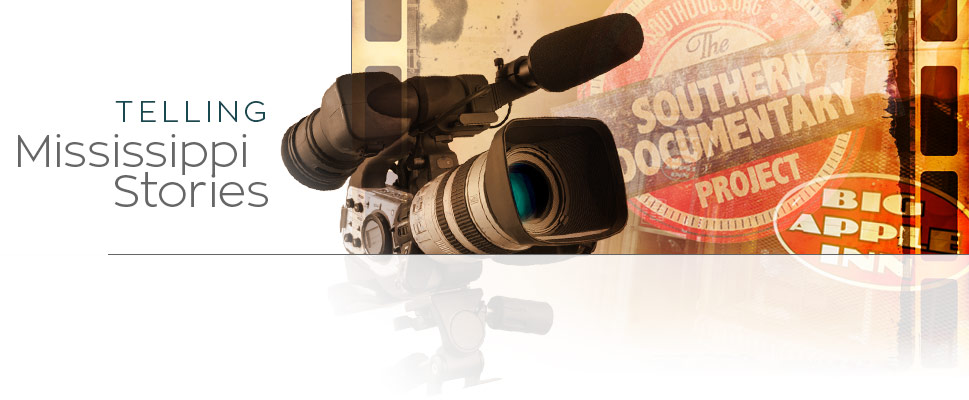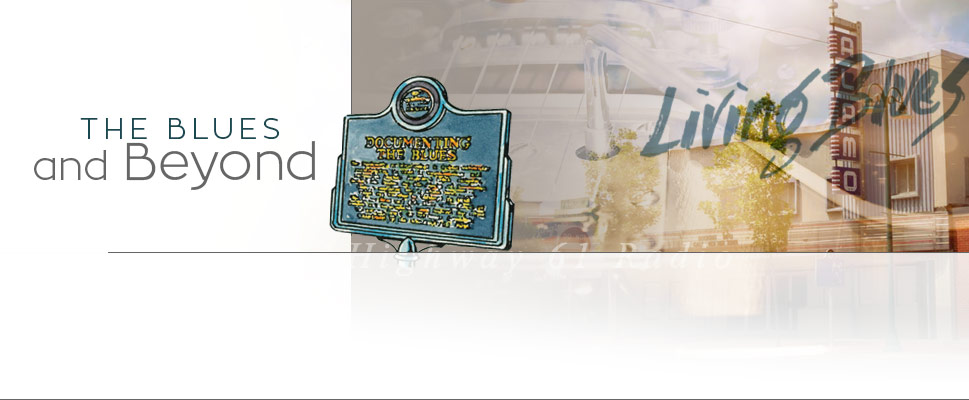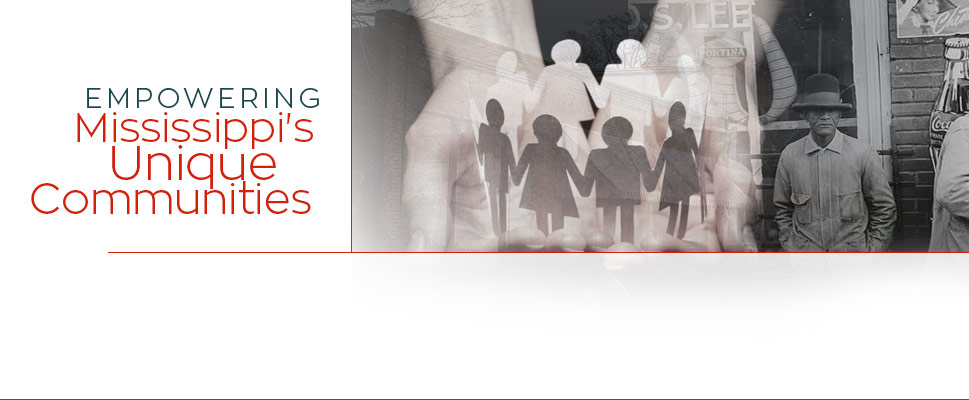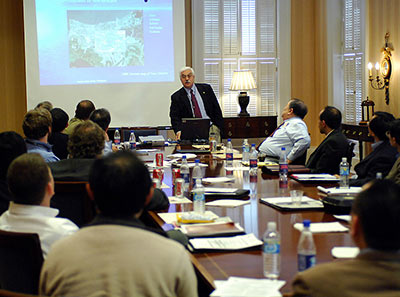
(’23) indicates current faculty and staff

BETHANY AIENA
RAY HIGHSMITH
Change Agents | The Unversity of Mississippi


BETHANY AIENA
RAY HIGHSMITH












When it comes to preparing for a natural disaster, any community’s planning efforts must start with emergency response. How will critical needs such as water and food be met? How will the injured and vulnerable be located and cared for? Yet when the rush to critical aid has passed, the longer-term questions loom: How will the community settle into the “new normal” that’s replaced the reality ...
In April 2010, the explosion of the Deepwater Horizon oil rig spread almost 5 million barrels of oil into the Gulf of Mexico, creating an environmental disaster of a magnitude never before seen. Three hundred miles from the coast, researchers at the University of Mississippi stood ready to offer their service and expertise. These are the stories of three UM researchers who led the way ...
Although it may seem counterintuitive, experimental work under way in the north Mississippi hills may show that tornadoes and forest fires are not ultimately harmful to woodland environments, and could even be a helpful tool in restoring the diversity of native plants and trees. Studying biodiversity is the passion of UM biology professor Steve Brewer, who has been pursuing separate projects in the Holly Springs National ...
Although they may be the tiniest living players in the Mississippi River’s food web, algae and bacteria are vital to sustaining the ecological health of the river and its tributaries. Clifford Ochs, associate professor of biology, has dedicated his research to understanding the river’s microbial ecology, including the connections between its microbiology, chemistry and physical characteristics. “Microorganisms are at the base of the food web. They’re ...
The most destructive river flood in the history of the United States swamped Greenville for eight weeks in 1927, its waters 30 feet deep. The damage was due in part to a levee failure at Mounds Landing, one so calamitous it left a 3,000-foot gap in the mainline levee system. Although there have been no failures of that magnitude since, disasters like the 2011 flood ...
For students working under UM biology professor Glenn Parsons, firsthand exposure to a critical decline in one important fish population has found them knee-deep in a net’s haul aboard shrimping boats in the Gulf of Mexico. “That means a lot of backbreaking work—picking shrimp out, picking snapper out, hauling the baskets and weighing them,” Parsons said. “Of course, I’m doing it alongside them. I’ve always enjoyed ...
How can we ensure that Mississippi’s water bodies are safe, not only for drinking water but also for recreation? The question drives Cristiane Surbeck, a UM associate professor of civil engineering, as she investigates water quality in the Ross Barnett Reservoir and tests a new device to detect pollution in the streams of the Mississippi Delta. “Ross Barnett Reservoir is the main source of drinking water ...
As our environment absorbs the byproducts of human activity, from the plastics we toss to the estrogenic compounds that leach into the water supply as a result of hormonal birth control use, the question is urgent: How do these contaminants affect our health and the health of generations to come? The University of Mississippi’s Environmental Toxicology Research Program is seeking answers. The cornerstone of Kristine Willett’s ...
Many of the tools used to monitor hurricane and tornado activity are surprisingly basic—from the eyewitness sightings used to establish tornado landings to the disposable instruments dropped into hurricanes by daredevil flight crews. To achieve the goal of more accurately pinpointing a tornado’s landing or measuring the intensity of a hurricane, researchers at the UM National Center for Physical Acoustics are developing sensors that gather data ...
In addition to studying why and how levee seepage may occur, the Mississippi Mineral Resources Institute is helping Delta communities assess flood risk and mitigate disaster by building an integrated geospatial database of the region’s critical facilities. Those critical facilities span from fire stations and hospitals to electric substations and waste treatment centers. Because the definition of a “critical facility” may differ from one county to ...
When the waters are rising and the threat to human lives is imminent, how can emergency managers know which areas must be evacuated most quickly? An integrated flood-simulation software developed by the UM National Center for Computational Hydroscience and Engineering, or NCCHE, is on its way to becoming a standard tool not only for emergency planning but also for swift analysis in the face of a ...








The works of Nobel Prize-winning writer William Faulkner made their way around the globe decades ago, delivering Mississippi stories to the world’s readers through more than a dozen languages. But 50 years after the author’s death, it’s thanks in part to the University of Mississippi that his fans are still able to, in a sense, come to him. “A great deal of his legacy has now fallen ...
While Mississippi’s music, literature and heritage draw visitors for what they can experience today, a new collaborative project will invite them to experience the Mississippi of a thousand years ago. Archaeologists at the University of Mississippi are partnering with researchers at three other institutions to create the Mississippi Mounds Trail, linking a chain of Indian mounds down Old Highway 61 from Memphis to Woodville. “The information we ...
From basketball player Mahmoud Abdul-Rauf to motivational speaker Zig Ziglar, there’s a lot more to Mississippi than meets the eye. It’s with the goal of offering as broad a view as possible of the Magnolia State that the UM Center for the Study of Southern Culture debuts The Mississippi Encyclopedia, set for publication in 2014. “This will be the first book of its kind in a hundred ...
For many years after the bloody riot that marked James Meredith's arrival on campus, the legacy of 1962 seemed like a burden to be overcome. Today, it's a legacy Ole Miss carries with open hands, as a steward for the future. "I think that our institution has more responsibility than any in the state for trying to lead Mississippi forward in race relations," said ...
The university’s work in researching, documenting and preserving the stories of Mississippi and the broader South finds its crossroads in Media & Documentary Projects. A division of the Center for the Study of Southern Culture, affiliated with the Meek School of Journalism and New Media, SouthDocs works both in cooperation with other campus departments and in projects of its own initiative. “Our mantra is to tell stories ...
What makes a place or person worthy to be noticed, studied, even memorialized? For music scholars at the University of Mississippi, there’s more to it than the usual qualifications of wealth, power and prominence. Through enterprises like Living Blues magazine, the Highway 61 radio show and the Mississippi Blues Trail, they’re delving deeply into the stories of humble men and women who turned struggle and sorrow ...
For all the riches to be found in the poor man’s music, there are as many stories to be sliced and savored at the Southern table. The study of food today as a fresh window into culture, history and society parallels the work of music scholars a generation ago, said John T. Edge, director of the UM-based nonprofit Southern Foodways Alliance. “For a long time, we as ...













Mississippi is establishing an arsenal of expertise in the fight against cancer, thanks in part to an innovative collaboration between the University of Mississippi’s National Center for Natural Products Research and the Cancer Institute at the University of Mississippi Medical Center. With a long-term goal of becoming a designated National Cancer Institute, the Cancer Institute has been expanding its capabilities in basic science research, clinical trials, ...
The Mississippi Healthy Students Act of 2007 gave the state’s public schools new mandates for physical activity programs and health education instruction. But how can policy makers know whether these changes are making a real difference? Teresa Carithers, professor of nutrition and hospitality in the UM School of Applied Sciences, is providing answers to that question. A nutrition epidemiologist, Carithers was contacted by the Center for ...
The expanding footprint of the National Center for Natural Products Research is poised to move University of Mississippi research one step closer to the marketplace. Phase II construction of NCNPR broke ground in 2012 and is expected to near completion in late 2014. The new research wing of 96,000 gross square feet will add 53,000 square feet of usable research space dedicated to advancing commercial development ...
The University of Mississippi’s Department of Nutrition and Hospitality Management has a motto: “Changing the culture of obesity—one child at a time.” For Kathy Knight, UM associate professor and interim chair of the department, the motivation to improve nutrition education in Mississippi public schools comes not only from knowing that the state has one of the country’s highest childhood obesity rates, but also from a ...
Greg Snyder knew the drawbacks of traditional stuttering treatments when he set out to determine whether a novel idea he’d had might provide an alternative. Snyder, associate professor of communication sciences and disorders, has a stutter, but he noticed a reduction in his own symptoms when he used his fingertips to feel his throat vibrate while speaking. His idea—that a tactile feedback device might be ...
For as long as civilizations have practiced medicine, people have searched for better, safer ways to deliver drugs. Today’s innovators are working with new technologies to design different kinds of drug-delivery systems, a prime area of research for Michael Repka, chair and professor of pharmaceutics, director of the Pii Center for Pharmaceutical Technology and research professor in the Research Institute of Pharmaceutical Sciences. Repka is an ...
When managers at General Electric Aviation’s facility in Batesville, Mississippi began implementation of HealthAhead, an employee wellness program, they discovered the help they needed was little more than 20 miles down the road at the University of Mississippi. Leaders at the facility enlisted Melinda Valliant, associate professor and director of the Department of Nutrition and Hospitality Management’s coordinated programs, to share what she knew about ...
A product on drugstore shelves gives testament to the creative collaboration between the University of Mississippi, the U.S. Department of Agriculture and the UM Medical Center. The product line, BluScience, contains pTeroPure® pterostilbene (pronounced “tero-STILL-bean”), a compound found in blueberries. An analog to resveratrol, the compound that is thought to give grapes and red wine beneficial effects, pterostilbene is believed to help the body produce enzymes ...
Although the challenges they face are immense, leaders in the UM Department of Pharmacy Practice are equipping young pharmacists with the skills they need to take a more proactive role in patient care. The department’s Community-Based Research Program is an ongoing effort comprising multiple projects geared toward determining how pharmacists can improve the wellbeing of Mississippi residents through better utilization, understanding and adherence to medications—what ...
Managing chronic pain presents doctors with major challenges—painkiller side-effects, such as increased tolerance and even addiction, can be hurdles to treatment. The answers to these challenges may lie in the unique drug compounds studied by Chris McCurdy, professor of medicinal chemistry and pharmacology and research associate professor in the UM Research Institute of Pharmaceutical Sciences. McCurdy is working with compounds that are highly selective for sigma ...
As long as there’s been commerce, there’s been product adulteration. From historic coffee traders who bulked up their product with chicory root to modern-day olive oil producers who substitute soy and canola oils, all merchants have faced the temptation to substitute less desirable ingredients for costly ones. But when it comes to botanical dietary supplements, purity is not only a consumer affair; it’s also a ...
In the United States, where as many as half of all prescription medicines aren’t taken as prescribed, lack of prescription adherence is a serious problem that escalates health care costs and compromises patient health. That’s why streamlining pharmacy practice is a win-win solution for pharmacists and their patients. RxSync®, a business model developed at the UM Center for Pharmaceutical Marketing and Management, helps pharmacists restructure their ...









Mississippi schools seeking to supplement their art programs don’t have to look far thanks to a no-cost program at the University of Mississippi Museum that delivers inspiring lessons directly to classrooms. The museum’s Traveling Trunks program provides K-12 educators with everything they need to give their students a unique art lesson. The trunks are linked to the museum’s permanent exhibitions, with a trunk each for Greek ...
Nurses, physicians, engineers, computer analysts and pharmacists—all these professionals will be indispensable in building Mississippi’s future workforce. That’s why the University of Mississippi is committed to advancing its programs in science, technology, engineering and mathematics and in STEM education. Alice M. Clark, vice chancellor for research and sponsored programs, directs the university’s Innovations in STEM Education Initiative, which received support through a grant from the National ...
A little school in Tunica County has something to shout about, thanks in part to a University of Mississippi program dedicated to helping literacy instructors excel. Dundee Elementary, a 179-student elementary school serving pre-kindergarten through fifth grade, received a Star rating in 2011, earning the Mississippi Department of Education’s highest performance classification, and received “high performing” status in 2012. Improving literacy instruction is a central concern of ...
Building the workforce of tomorrow begins with teaching children how to prepare for mathematics and science careers. With that goal in mind, the UM Center for Mathematics and Science Education, or CMSE, is developing ways to help improve mathematics and science education in Mississippi K-12 schools. That mission includes educational development, professional development, research and science, technology, engineering and mathematics outreach. Launched in December 2006 with a ...
Jason Ritchie, associate professor of chemistry and assistant dean of undergraduate research at the Sally McDonnell Barksdale Honors College, learned firsthand the benefits of undergraduate research. Ritchie earned his bachelor’s degree in chemistry in 1994 at the University of California at San Diego. Under the mentorship of an excellent adviser, Ritchie performed research on conducting polymers, an experience that revealed to him a much broader, deeper ...
A new collaborative effort between the University of Mississippi and Mississippi State University aims to attract exceptional students to the teaching profession—and to keep them there. Launched in fall 2012, the Mississippi Excellence in Teaching Program (METP) provides fully funded undergraduate scholarships to students who commit to teaching in Mississippi’s public schools for at least five years following graduation. Each university sponsors twenty new fellows a ...
A school ultimately will be no stronger than its principal. Results from the Barksdale Reading Institute have demonstrated that although the path to transforming a school’s culture may be daunting, a dynamic leader can change that ethos and the school can experience skyrocketing student performance. In its 14th year, the Barksdale Reading Institute is applying its experience and educational research to demonstrate what can be accomplished ...
When Landon Pollard arrived on the University of Mississippi campus in 2002, he had no idea he’d soon be launched on a major leadership trajectory. In less than a decade, Pollard’s participation in two UM programs transformed him from an inexperienced college freshman into the principal of Byhalia Middle School in Marshall County. A native of Birmingham, Ala., Pollard thrived as a student in the Sally ...












In situations where Mississippians need legal help but can't afford it, the UM Civil Legal Clinic is doing its part to fix the problem while preparing the next generation of Mississippi lawyers to blend public interest practice into their legal careers. Operating as a class in which students can enroll for credit, gain professional experience and learn how to apply the theories they have learned ...
Growing the number of health care professionals in the state, reducing health disparities, improving education and making economically sound development choices—all are goals that can be tackled more effectively through teamwork. Through the Institute for Community-Based Research, a multi-organizational collaborative of academic researchers, students and nonprofit leaders, the University of Mississippi’s Center for Population Studies is providing assessment, evaluation and developmental guidance for a portfolio ...
In the nation’s poorest state, alleviating poverty is a complicated task and will require a collective effort. The University of Mississippi’s McLean Institute for Public Service and Community Engagement aims to improve quality of life for all Mississippians by fighting poverty through education and serving as a cohesive force for building partnerships on and off the UM campus. “The McLean Institute has an opportunity to expand ...
Starting a business is a major risk. With hard work and dedication, the rewards may be great, but the path to success is often paved with unforeseen obstacles and setbacks. A resource to smooth out that road is the University of Mississippi’s Applied Research and Innovation Hub, which opened its doors in January 2012. The Applied Research and Innovation Hub is housed at Insight Park, the ...
Persevering for more than 130 years in one of the nation’s most economically fragile regions, Mound Bayou has a fascinating history: it was the first all-black community established by freed slaves in the Mississippi Delta. The University of Mississippi’s Department of Social Work has launched a program to work with the community in preservation and development efforts with the ultimate goal of fostering healthy lifestyles, ...
Mississippi bears the heavy weight of history when it comes to race relations. According to the William Winter Institute, this history gives Mississippi both the opportunity and responsibility to lead the nation’s continuing path toward equality. For more than 10 years, the William Winter Institute for Racial Reconciliation has been a partner in Mississippi’s efforts to learn, grow and heal. That path toward progress includes confronting ...
Although the small businesses that have weathered the recession may get little press or praise, there’s no denying their importance or the critical duty of helping them stay afloat. The UM-based Mississippi Small Business Development Center provides this life raft, counseling small business owners as they start, develop and sustain their companies. “We’re a state of small businesses,” said Robert Forster, chief operations officer of the ...
Persevering for more than 130 years in one of the nation’s most economically fragile regions, Mound Bayou has a fascinating history: it was the first all-black community established by freed slaves in the Mississippi Delta. The University of Mississippi’s Department of Social Work has launched a program to work with the community in preservation and development efforts with the ultimate goal of fostering healthy lifestyles, ...
Fifty years ago, prosecutors could rely on paper trails and crime scene photos to provide courtroom evidence. But the transition from a paper-based world to a digital one has brought many murky questions. In today’s digitized society, where does privacy end and what are the limitations of a search warrant? Questions like these represent the core of the Cybercrime Initiative led by the University of ...
With more than 650 people incarcerated per 100,000 residents, Mississippi has one of nation’s highest per capita incarceration rates, and it’s a harrowing fact that some of those people are serving time for crimes they did not commit. Since its establishment in 2007, the University of Mississippi-based Mississippi Innocence Project has provided legal aid and expertise to exonerate nine innocent men. Wrongfully convicted for murder, rape, ...
On the model factory floor of the Haley Barbour Center for Manufacturing Excellence, freshmen from three different University of Mississippi schools test their chops, learning the basics of manufacturing techniques in plastics, welding, 3-D printing and more. The CME students aren’t planning to work on the line, but the experiences will inform their expertise as they assume professional roles. Entering the workforce, they will be graduates ...
Change Agents is produced by the University of Mississippi Office of the Vice Chancellor for Research. For additional information on research at The University of Mississippi or if you would like to become involved by helping support a particular research effort, please email research@olemiss.edu
Editor-in-Chief
Associate Editor
Writers
Emily Howorth and Lucy Schultze
Assistant Editor
Designer
Photographers
© iStock, Kevin Bain, Robert Jordan, Nathan Latil
Home page and background illustration
Russ Charpentier

2014: Alice Clark
Vice Chancellor
for Research
In his introduction to My Mississippi, author Willie Morris wrote that he’d once heard William Faulkner say, “To understand the world, you have to understand a place like Mississippi.”
The University of Mississippi is full of people who are striving to attain that understanding – and to applying what they learn to the greater goal of fostering positive change in Mississippi.
The 2014 issue of Change Agents highlights the exceptional work of more than seventy University of Mississippi researchers, faculty members, staff members, alumni, and students.
Whether they are working towards protecting our environment, supporting our communities and education systems, understanding our history, or addressing our state’s unique health challenges, these Change Agents are all examples of the University of Mississippi’s longstanding commitment to service and leadership.



Ted Ownby
From basketball player Mahmoud Abdul-Rauf to motivational speaker Zig Ziglar, there’s a lot more to Mississippi than meets the eye.
It’s with the goal of offering as broad a view as possible of the Magnolia State that the UM Center for the Study of Southern Culture debuts The Mississippi Encyclopedia, set for publication in 2014.
“This will be the first book of its kind in a hundred years. It’s a big obligation,” said Ted Ownby, CSSC director and a professor of history and Southern studies. “It’s the kind of book we hope will be on every coffee table and in every school library, as well as being a resource to journalists and business people.”
The project was proposed by the University Press of Mississippi and has involved collaboration with the Mississippi Humanities Council, Mississippi Department of Archives and History and Mississippi Arts Commission.
The Center for the Study of Southern Culture was well positioned to take on such an effort, having produced The Encyclopedia of Southern Culture in 1989 and its 24-volume expanded second edition completed in 2013.
The Mississippi Encyclopedia will be similar in scale to the original 1,600-page Encyclopedia of Southern Culture. The Mississippi project enlisted more than 300 writers to craft some 1,500 entries, which are organized alphabetically rather than by theme.
While the effort avoided setting a particular thesis or agenda, its governing ideas were those of inclusiveness and surprise, Ownby said.
“Inclusiveness, in trying to get the whole range of Mississippi experiences into one book, to the degree that we can,” he said. “And surprise, in that I think a lot of people have one or two ideas about Mississippi, and this project will show many, many more facets of the state.”

Ted Ownby (left) and Charles Wilson (right)
talk tamales
The elements of surprise and discovery are magnified by the medium itself, Ownby said. While many states have published state encyclopedias online as an evolving guide and resource for the public, the choice to publish Mississippi’s in book form was intentional.
“Websites can be hard to thumb through,” Ownby said. “With a book, you’ll find one entry alphabetically next to another, so there’s a greater possibility for the experience of learning the unexpected.”
Many of the stories that encyclopedia readers will come across won’t be the flattering variety.
“It’s important that people know an encyclopedia isn’t intended as a celebration,” Ownby said. “We have an obligation to get right the worst sides of Mississippi. And along with that, it’s our job to include lots of people and groups who have critiqued and worked to address those troubled sides.”
From A to Z, the goal is a balanced and sober reflection, from stories of the state’s troubled past to the remarkable writers, artists and musicians Mississippi has produced.
Such cultural contributions were not a focus back in 1907, when the last attempt at a Mississippi encyclopedia was made. The Encyclopedia of Mississippi History by Dunbar Rowland, then head of the Mississippi Department of Archives and History, was more concerned with the state’s early history and geography.
“If there is surprise when people look at The Mississippi Encyclopedia, it will be the choices we have made and the range of topics we’ve included,” Ownby said, adding that Rowland has an entry of his own in the new encyclopedia.
“There are all sorts of decisions we’ve had to make about who’s important, what’s important,” Ownby said. “We hope that this volume will give people new topics to think about and new ways to think about Mississippi.”


Mustafa Altinakar
When the waters are rising and the threat to human lives is imminent, how can emergency managers know which areas must be evacuated most quickly?
An integrated flood-simulation software developed by the UM National Center for Computational Hydroscience and Engineering, or NCCHE, is on its way to becoming a standard tool not only for emergency planning but also for swift analysis in the face of a flood or hurricane.
“This new technology is unique in the world, and it is being offered free-of-charge to stakeholders of the Department of Homeland Security,” said NCCHE Director Mustafa S. Altinakar, a world-renowned computational hydroscientist who led the software’s development.
“When a dam fails, the huge amount of water impounded upstream is released downstream as a catastrophic flood,” he said. “If you have a population living downstream, that could mean loss of life, property damage and environmental damage. An emergency action plan based on numerical simulation is needed to identify which areas are likely to be flooded—and therefore, which populations must be evacuated.”
The Decision Support System for Water Infrastructural Security, or DSS-WISE, software created at the NCCHE does just that and is helping emergency managers around the nation in making informed decisions on evacuation plans in real time. DSS-WISE is being used by agencies such as the Headquarters and District offices of the U.S. Army Corps of Engineers, including the Vicksburg District and the USACE Engineer Research and Development Center, as well as the Mississippi Department of Environmental Quality, and the Department of Homeland Security Dams Sector Branch.
Beginning in 2007, the software was developed through multiple fundings from the DHS Science and Technology Directorate under the SERRI, or South East Region Research Initiative, Program, monitored by Oak Ridge National Laboratory. In 2012, the NCCHE developed a Web-based automated version of the software called DSS-WISE Lite, in collaboration with the DHS Dams Sector Branch and U.S. Army Corps of Engineers Headquarters.
The automated version is accessed via DHS’s Dams Sector Analysis Tool, or DSAT, a Web-based application hosted by Argonne National Laboratory where dam owners and operators have secure access to state-of-the-art analytical capabilities to study more than 87,000 dams across the country that are registered in the National Inventory of Dams.
Using a GIS-based graphical user interface developed under DSAT, users can quickly and efficiently define dam-break scenarios and submit simulation requests to the NCCHE computer server on the UM campus on any day at any time. Input data is prepared and simulations are processed swiftly, without any human intervention, and the results are made available to the user on a secure FTP site.
“Generally, the simulations at 30-meter resolution are finished before half an hour, while those at 10-meter resolution may last a couple of hours,” Altinakar said. “The users get their inundation maps very quickly, and can use them to analyze daytime and nighttime populations living in that area, and the number of residential buildings and critical infrastructures that are in danger of flooding.”
The service began as a single-state pilot program in February 2012. By the end of March, 21 states were participating in the pilot study, and in 2013, the automated dam-break flood simulation and mapping tool were made available to all 50 states. As of April 2014, a total of 1961 simulation requests have been submitted by 81 users from 37 states, including dam owners, state dam-safety officials and emergency managers, all looking to lower costs of dam safety studies, work faster and make informed planning decisions. The number of requests is constantly increasing, with the system performing on average 5-6 simulations per day.
FEMA’s Region 4, covering eight Southeastern states, including Mississippi, tested DSAT/DSS-WISE Lite as an emergency management tool during the 2013 hurricane season. The system may be adopted as a standard tool for all FEMA regions nationwide. USACE Modeling Mapping and Consequences (MMC) Production Center has been pilot testing DSS-WISE Lite to manage a portfolio of 700 dams owned and operated by USACE.
Emergency managers in Mississippi appreciated the value of the software tool during the 2011 spring floods, during which the NCCHE calculated several hypothetical levee breaches along the Mississippi River. When Hurricane Isaac struck in late August 2012, the NCCHE was called upon again to calculate the risks from dams in danger of failing, including one at Percy Quin State Park in Pike County.
“We received phone calls asking us to provide the inundation maps showing what would happen if the dam failed,” Altinakar said. “We were able to simulate the dam-break failure in less than half an hour, and to provide the maps of maximum flood depth and arrival time to a distance of 65 miles downstream.”

Mustafa S. Altinakar
Later in the same week, waters in the swollen Pearl River threatened a failure at Lock 2 north of New Orleans. As residents downstream in Mississippi and Louisiana faced the threat of flooding, NCCHE scientists raced to campus to provide flood-simulation maps needed by FEMA Region 4.
After the incidents, thank-you letters poured in from federal agencies and governors’ offices.
More than one-third of about 25,000 high-hazard and significant-hazard dams around the country do not have emergency action plans in place. In addition, existing emergency action plans need to be regularly reviewed to take into account eventual developments downstream. This puts an enormous burden on state dam safety officials who are in charge of dam safety.
The DSS-WISE tool gives dam-safety officials the chance to create those plans at the moment they’re most needed—fast and free of charge.
“We are saving millions of taxpayer’s dollars by providing this service,” Altinakar said. “Each dam analysis done by an engineering company would cost at least $10,000 and take up to a couple of months to complete.”
The technology stands to provide a host of future opportunities for the NCCHE and Ole Miss. A new contract with the U.S. Army Corps of Engineers and Argonne National Laboratory in Chicago is allowing the NCCHE to develop new capabilities for the automated analysis system, while other contracts are pending.
Altinakar is receiving inquiries from countries including Canada and Brazil about the possibility of using DSS-WISE technology to provide mapping for their dam systems.